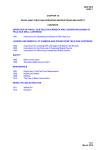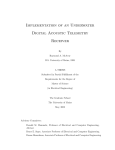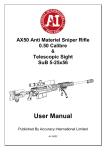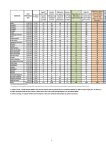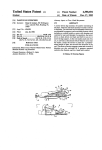Download Chapter 18 - Junior Leaders Field Gun Operating Instructions and
Transcript
BRd 9615 PART 2 CHAPTER 18 JUNIOR LEADERS FIELD GUN OPERATING INSTRUCTIONS AND SAFETY CONTENTS OPERATION OF NAVAL 12lb FIELD GUN BREECH AND LOADING/UNLOADING OF FIELD GUN DRILL CARTRIDGE Para 1801. Instructions for Operating the Breech of RN Field Gun LOADING AND REMOVAL OF 5.56MM BLANK ROUND FROM FIELD GUN CARTRIDGE 1802. 1803. 1804. Instructions for Loading Drill Cartridges with Blank 5.56 Rounds Instructions for the Removal of Expended Blank Rounds Instructions for Removing Unexpended Blank Rounds SAFETY 1805. 1806. Blank Ammunition Simulator Battle Sound L35A1 MAINTENANCE 1807. 1808. Royal Navy 12lb Field Gun Maintenance Health and Safety 18-1 March 2015 BRd 9615 PART 2 CHAPTER 18 JUNIOR LEADERS FIELD GUN OPERATING INSTRUCTIONS AND SAFETY OPERATION OF NAVAL 12LB FIELD GUN BREECH AND LOADING/UNLOADING OF FIELD GUN DRILL CARTRIDGE 1801. Instructions for Operating the Breech of RN Field Gun The breech of the Naval 12lb Field Gun is operated as follows: Fig 18-1. Breech Closed a. Fig 18-1 shows the breech in the closed position with the breech handle fully home. b. To open the breech, the No1 Trainer, Firing Number or Track Judge places their hand on the breech handle and pulls away from the barrel and to the right of the gun trail, such that it moves from left to right in an arc. The mechanism rotates and unlocks the threaded splines inside the breech and swings open as shown in Fig 18-2. Note. The firing pin is inside the small recess on the flat face on the inside of the breech. Fig 18-2. Breech Open 18-2 March 2015 BRd 9615 PART 2 c. The drill cartridge is inserted as per Fig 18-3 and Fig 18-4. The cartridge is inserted inside the barrel and pushed fully home so the lip of the drill cartridge is flush with the barrel recess. Fig 18-3. Cartridge Ready to be Inserted Fig 18-4. Cartridge Inserted d. The breech handle is then gripped as per Fig 18-5 and moved from right to left across the rear of the barrel chamber. When the breech closes (Fig 18-6), the operating mechanism allows the firing pin to move forward and strike the base of the blank 5.56 round resulting in the expenditure of the round. Note. The breech need only be closed sufficiently to affect the expenditure of the blank 5.56 round. Fig 18-5. Breech Ready to be Closed Fig 18-6. Breech Closed WARNING OBSTRUCTION DANGER. CARE MUST BE TAKEN TO ENSURE THAT THERE ARE NO OBSTRUCTIONS THAT MAY IMPAIR THE CLOSURE OF THE BREECH I.E. THE HAND THAT INSERTED THE CARTRIDGE. e. Once the cartridge has fired the breech is then re-opened and the drill cartridge is extracted using the extractor by the extracting member of the gun crew (Fig 18-7, Fig 18-8 and Fig 18-9). The extracting member is also known as the ‘scratcher’. 18-3 March 2015 BRd 9615 PART 2 Fig 18-7. Breech Open Extractor Inserted Fig 18-8. Cartridge Removed Fig 18-9. Breech Empty f. This drill is repeated 3 times at each of the first and second actions. Once the action is complete the breech is then fully closed until the splines reconnect inside thus locking the breech (Fig 18-10). Fig 18-10. Breech Closed and Locked 18-4 March 2015 BRd 9615 PART 2 LOADING AND REMOVAL OF 5.56MM BLANK ROUND FROM FIELD GUN CARTRIDGE 1802. Instructions for Loading Drill Cartridges with Blank 5.56 Rounds a. The firing number should inspect all 6 drill cartridges prior to use and use a file to take off any sharp burrs that may cut or lacerate human skin. The qualified member of the crew is to collect 6 x blank 5.56 rounds from the appropriate stowage in order to be loaded. b. Blank Rounds are to be inserted using the approved method, at no stage are rounds to be “Crimped” as this is illegal; hitting a blank round with a hammer distorts the jacket of the blank round. Clear sticky tape placed over the drill cartridge to hold in place the blank 5.56 round is acceptable and to be brought to the attention of the judge prior to each run if employed. 1803. Instructions for the Removal of Expended Blank Rounds a. Check that the base of the round has been struck (small indentation on the base of the percussion cap (Fig 18-11)). If the round has not been struck, fit Shell into breech and re-fire. If round fires proceed to next paragraph, if not check base to see if percussion cap has been struck. If the percussion cap has not been struck there maybe a defect with the firing pin; check firing pin. Fig 18-11. Struck Round b. If the blank round percussion cap has been struck, place the Shell upside down. Inspect with a torch to confirm that the round has fired (crimping on round should have opened up to fill the chamber of the Shell) (Fig 18-12). If crimping has not opened up, the round has not been fired. Once again try a re-fire, if unsuccessful return Shell to Collingwood for removal of round. If unable to confirm state of crimping on blank round proceed as in Para 1804. Fig 18-12. Fired Blank Round 18-5 March 2015 BRd 9615 PART 2 c. Before removal of the fired round a final safety check is required. With the Shell upside down, place a depth gauge inside the cartridge chamber. The depth gauge should go in 2.5 inches to indicate that round has fired (Fig 18-13). The depth gauge can be made with screwdriver NSN O273 136 5597, with the blade cut to 2.5 inches (Fig 18-16). When the handle of the screwdriver rests on the Shell adapter, the round has been fired. If the depth gauge does not go in 2.5 inches (Fig 18-15) the Shell should be returned to Collingwood for removal of suspect live blank round (Fig 18-14). Fig 18-13. Fired Round (Depth Gauge Fully Inserted) Fig 18-14. Unfired Blank Round Fig 18-15. Unfired Round (Depth Gauge Fouled on Live Blank Round) Fig 18-16. Depth Gauge d. A rubber/plastic mallet, a drift of suitable length and 3 inches deep by 5 inches wide by 12 inches long (approximately) section of timber with a hole drilled in the centre to allow spent cartridges to drop through is required for this evolution. This will prevent damage to the base of the Shells. e. To remove a confirmed fired blank round, use a long shafted drift and hammer. Place the drift into the adapter of the upside down Shell and hammer the drift until the fired blank round comes out. 1804. Instructions for Removing Unexpended Blank Rounds The removal of live blank rounds is to be conducted by HMS COLLINGWOOD Armoury Staff Only. When conducting this drill personnel are to wear safety goggles/gloves/ ear defenders and ensure that a safety number is in attendance at all times. a. Confirm that live blank round is fitted in Field Gun Cartridge (FGC). Can be confirmed by inspecting with a torch to see if the blank round is crimped and placing a depth gauge inside the cartridge chamber (confirmed live round if depth gauge does NOT go in 2.5 inches). Once confirmed a live blank round, place FGC in Gun; attempt to fire off (3 times). If the round fires, remove in accordance with Para 1803 above, if not proceed to next paragraph. 18-6 March 2015 BRd 9615 PART 2 b. Wearing safety equipment, with FGC in Gun, use a punch and hammer to hit the percussion cap of the blank round. This may fire the round. If the round fires, remove FGC from gun and remove fired blank round in accordance with paragraph 4 above. If the round does not fire, the percussion cap should have a visible hole in it; remove FGC from Gun. c. Wearing safety equipment, the suspect live blank round can be removed by placing the FGC in a vice upside down. Placing a long drift in FGC adapter and keeping well back; hold the drift with a pair of long welding tongs and gently tap the drift with a long handled hammer to remove the suspect round. d. The suspect live blank round is to be returned to Joint Support Chain Services (JSCS) Gosport. SAFETY 1805. Blank Ammunition It must be appreciated that a weapon loaded with Blank Ammunition can present a considerable hazard. HMS COLLINGWOOD Gunnery Staff and Armourers have done extensive testing and the safety precautions given at Table 18-1 (which have been adapted from the Blank Ammunition Safety Precautions as laid down in BRd 8988), must therefore be taken: Table 18-1. Blank Ammunition – Safety Precautions Concerning Action or Requirement Safety Distance THE AREA IN FRONT OF THE MUZZLE (END OF BARREL) IS TO BE CLEAR OF ALL PERSONNEL OUT TO A RANGE OF 5 METRES (16.5 ft). Noise Danger ALL PERSONNEL CLOSED UP ON THE GUN FOR THE FIRST AND SECOND ACTIONS ARE TO WEAR EAR PROTECTION. 1806. Simulator Battle Sound L35A1 The Simulator Battle Sound L35A1 (SBS) is a hand thrown pyrotechnic training device designed to simulate generic battle sounds and replaces the N2 and N5 Thunderflash. It must be appreciated that the explosive content of a pyrotechnic can cause considerable injury, if not death, if used incorrectly or carelessly therefore, personnel charged with the use of pyrotechnics are to be in possession of the relevant qualification and comply with all instructions detailed in Army Pamphlet 13. Personnel from INM with the RNRMC FG Executive have conducted safety tests within HMS COLLINGWOOD and SBS L35A1 have been approved for safe use within the establishment. Agreed safety precautions can be found at Table 18-2 and are to be used during the FG competition, they are also to be used as guidance for external events. 18-7 March 2015 BRd 9615 PART 2 Table 18-2. Simulator Battle Sound L35A1 – Safety Precautions Concerning Action or Requirement WHEN USED AT TATTOOS OR DISPLAYS THE FOLLOWING SAFETY DISTANCES ARE TO BE OBSERVED FROM THE POINT OF BURST: Safety Distance 1. WHEN THE GENERAL PUBLIC IS PRESENT. – 100 METRES (325 ft). IN CASES WHERE A DISTANCE OF 100 METRES IS NOT OBTAINABLE, THE UNIT CONCERNED IS TO APPLY TO THE LOCAL ATO FOR AUTHORITY TO USE A SHORTER DISTANCE FOR THAT OCCASION. 2. WHEN THE GENERAL PUBLIC IS NOT PRESENT. – 10 METRES (32.5ft). Noise Danger THE BATTERY COMMANDER IS TO WEAR THE APPROPRIATE EAR PROTECTION WHEN USING THE SIMULATOR BATTLE SOUND L35A1 TO START FIELD GUN RUNS. MAINTENANCE 1807. Royal Navy 12lb Field Gun Maintenance a. The entire 12lb Royal Navy Field Gun maintenance schedule is carried out by HMS COLLINGWOOD. The Executive Committee has 2 positions for maintainers who ensure that all gun and limbers have a yearly Series Inspection and any defects are recorded, costed and undertaken by commercial experts within the engineering field. The 12lb Field Gun and limber maintenance areas are concentrated on the breeches, wheels, woodwork and general condition of the carriage. The following inspections are carried out by the maintenance team; barrel is securely mounted on the carriage via pip pins and spigots, the breech can be opened and closed cleanly, the overall condition of the carriage is sound with no sharp edges, the wheels are sound with the hub bolts are all secured and spokes and felloes are tightly fitted with no major gouges and the metal tyre is in place. The limber box also needs to be sound and the drag ropes fit for purpose. b. No.1. Trainers are responsible for the care and upkeep of Field Guns and Limbers in their possession during the Field Gun season. No alterations can be carried out on the equipment iaw JLFGIs and all defects are to be brought to the attention of the Chief Maintainer at the earliest opportunity. Whilst on loan, the No.1 Trainer needs to ensure that the breech is kept rust free and the firing pin replaced if becomes too blunt, the wheel spokes remain tight and the woodwork sanded if required. All nuts and bolts need to be regularly tightened and any sharp edges need to be filed or taped as required to make them safe. The slat pole needs to remain tight within its socket attaching it to the limber. c. The cost of maintenance is covered by funding from 2SL and entry fees from Crews. Firing pins, drill cartridges and pins can be replaced as necessary and any costs for lost or damaged equipment will be charged to the Ship or Establishment at the discretion of the RNRMC FG Executive Committee (RNRMC FGEC). Note: A limited supply of RNRMC FG stores is held. 18-8 March 2015 BRd 9615 PART 2 d. Field Guns can be maintained when Crews attend Junior Leaders Field Gun Week at the Maritime Warfare School HMS COLLINGWOOD 1808. Health and Safety In accordance with current Defence H&S policy, HMS COLLINGWOOD Armoury staff will provide the necessary safety documentation and risk assessments as the host establishment. 18-9 March 2015









